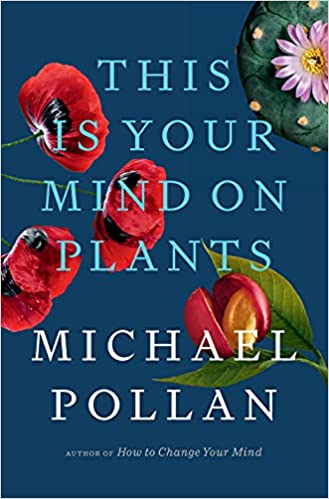Michael Pollan
Penguin Press
New York
2021
274 pages
According to the art:
Michael Pollan continues pursuing his interest in the human drive for altering consciousness through mind-altering substances he started with his previous book, and marries this interest with his passion for plants and gardening. In this book, he investigates through personal experience, opium, caffeine, and mescaline.
Synopsis:
Michael Pollan is curious about human consciousness and how humans alter it using a variety of molecular compounds. This curiosity took him first to three mind-altering psychedelic drugs: psilocybin, lysergic acid diethylamide (LSD), and 5-MeO-DMT (“The Toad”). He reported his findings and personal experiences in a 2018 book, How to Change Your Mind. His curiosity yet untamed, Pollan expands his project to three mind-altering compounds found in plants: opium, caffeine, and mescaline. He reports his findings in his latest book, This is Your Mind on Plants.
Pollan’s investigation is born of his vocation as a gardener “fascinated by our attraction to these powerful plants as well as by the equally powerful taboos and fraught feelings with which we surround them.” He’s further attracted to them for the way in which when “we take these plants into our bodies and let them change our minds, we are engaging with nature in one of the most profound ways possible.” (p. 3) The sources he chooses are the opium poppy for opium; coffee and tea for caffeine; and peyote and San Pedro cacti for mescaline.
Opium, caffeine, and mescaline represent the range of mind-altering properties available from plants of interest to Pollan. In opium he saw a sedative, in caffeine a stimulant, and in mescaline a hallucinogen, or as he characterizes them, the “downer, the upper, and the outer,” respectively. (p. 4) Their effects on consciousness do not feature dissolution of the ego, as is the case with psychedelics, and indeed, they can solidify ego. Seemingly most important to his selection, however, was that,
Taken together, these three plant drugs cover much of the spectrum of the human experience of psychoactive substances, from the everyday use of caffeine, the most popular psychoactive drug on the planet; to the ceremonial use of mescaline by Indigenous peoples; to the age-old use of opiates to relieve pain.
p. 4
The book comprises an introduction and a chapter each covering opium, caffeine, and mescaline. The introduction describes his dual interest in the ancient human drive to fool with consciousness, and in plants that produce mind-altering substances as evolutionary features. Pollan also touches on how civilizations, ancient and current, aid and combat the use of these substances, at times simultaneously. In the chapter on opium, Pollan updates his April, 1997 Harper’s Magazine article about his experience growing opium poppies as the war on drugs peaked in the mid-1990s; in this version he reconstitutes the section he left out for fear of arrest and conviction that has since abated. In the next two chapters, Pollan separately reports on how caffeine and mescaline affected his consciousness. Because he was already a heavy caffeine user, Pollan had to give up coffee and tea if he was to discern its mind-altering effects, but for mescaline’s mind-altering effects, he had to find a source, a setting, and a guide through the maze the Covid-19 pandemic created.
Analysis:
Pollan continues pursuing his interest in the human drive for altering consciousness through mind-altering substances he started with his previous book, and marries this interest with his passion for plants and gardening. He is a journalist, and usually reports from the field. In this case, the fields were mostly between the fences of his garden, between the opposite ends of Zoom calls, and between his conscious and subconscious being.
Context mattered for Pollan’s investigations. Humans have been using his three subject substances for thousands of years, and over that time they served different purposes in different environments, which produced a variety of use patterns, cultural trends, public policies, laws, and social norms and taboos. Pollan thus encountered and reported many paradoxes, contradictions, and inconsistencies attendant with mind-altering substances individuals seek and groups want to control (e.g., governments, churches, indigenous peoples, special interest groups). He notes that members of the Women’s Christian Union imbibed opium tonics after crusading against the evils of alcohol all day. He tells of how he can fill his garden with toxic plants, but only the opium poppies put him at legal risk. He realizes that “most caffeine today is being used to compensate for the lousy sleep that caffeine causes” (p. 136). The war on drugs, he observes, was really the war on “some” drugs.
Besides reporting the effects these substances produced on his own consciousness, Pollan morphs from journalist into historian and anthropologist when he covers how they figured in world history and human development. As he considers opium, he asks,
Is there another flower that has had anywhere near the opium poppy’s impact on history and literature? In the nineteenth century, especially, the poppy played as crucial a role in the course of events as petroleum has played in our own century: opium was the basis of national economies, a staple of medicine, an essential item of trade, a spur to the Romantic revolution in poetry, even a casus belli.
p. 31
About caffeine, he says,
Caffeine’s big contribution to human progress has been to intensify spotlight consciousness—the focused, linear, abstract, and efficient cognitive processing more closely associated with mental work than with play. This, more than anything else, is what made caffeine the perfect drug not only for the age of reason and the Enlightenment but for the rise of capitalism, too.
p. 119
The widespread use of caffeine is, arguably, one of those developments in human history, like the control of fire or the domestication of plants and animals, that helped lift us out of the state of nature, providing a new degree of control over biology, in this case our own.
pp. 126-127
While he does not credit mescaline with having contributed to human progress in such grand scales, he speaks of its power in healing the most devastating wounds.
What peyote chiefly heals is trauma in its various collective and individual manifestations, [such as those inflicted from the] enduring legacy of official policies that sought nothing less than ‘the destruction of Native American cultures.’
p. 212
To be sure, Pollan covers the destruction these substances have wrought as well. He recognizes the opioid epidemic fueled by commercial and illicit sources that was ongoing well before and while he wrote and was killing tens of thousands of people in the U.S. each year. He also recognizes the human toll caffeine exacts.
Almost from the start, the blessings of coffee and tea in the West were inextricably bound up with the sins of slavery and imperialism, in a global system of production organized with such brutal rationality that it could only have been fueled by—what else?—caffeine itself.
p. 138
Pollan makes a concerted effort to support his sweeping generalizations about the breathtaking contributions opium, caffeine, and mescaline have made to civilization. Such attributions, however interesting and arresting, require more scholarly and expert sources before we believe them unreservedly. If true that changes in consciousness determine world events and human development, the drive for mind-altering substances will continue on and give Pollan and others more time for these assessments.



